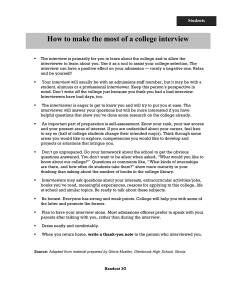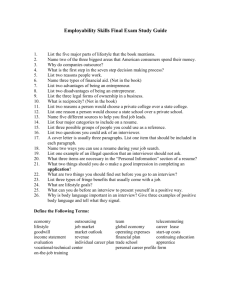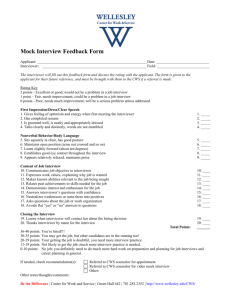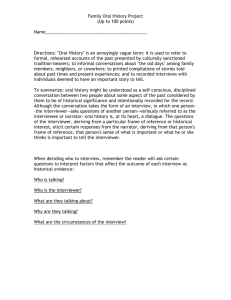Case/Structured Interviews (PDF)
advertisement
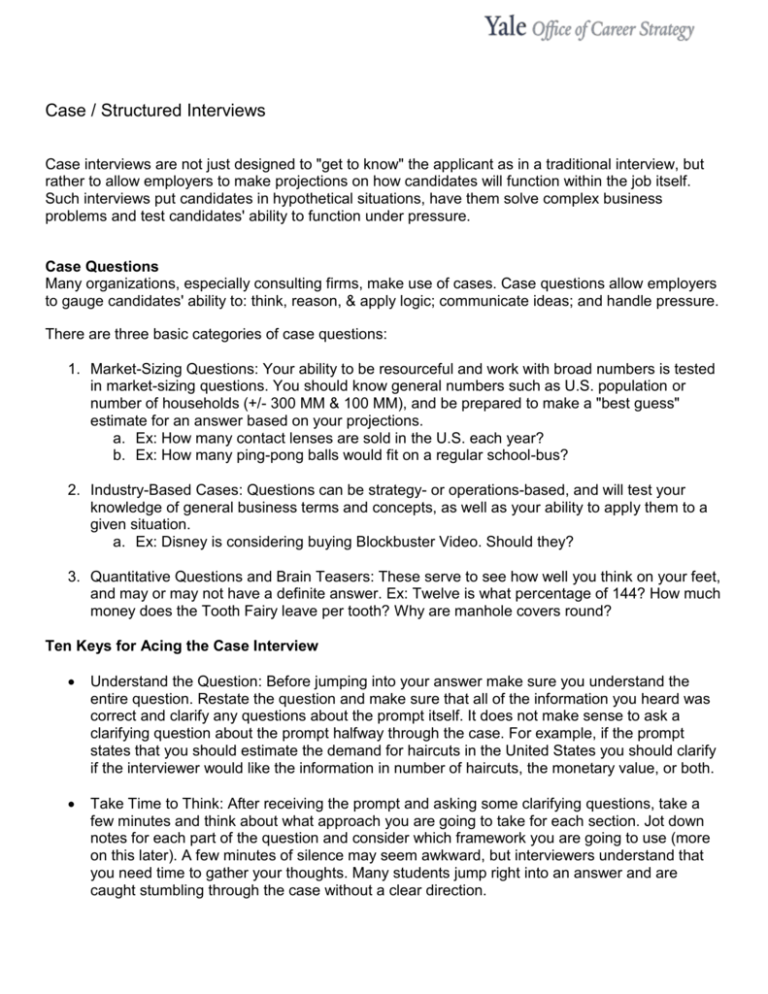
Case / Structured Interviews Case interviews are not just designed to "get to know" the applicant as in a traditional interview, but rather to allow employers to make projections on how candidates will function within the job itself. Such interviews put candidates in hypothetical situations, have them solve complex business problems and test candidates' ability to function under pressure. Case Questions Many organizations, especially consulting firms, make use of cases. Case questions allow employers to gauge candidates' ability to: think, reason, & apply logic; communicate ideas; and handle pressure. There are three basic categories of case questions: 1. Market-Sizing Questions: Your ability to be resourceful and work with broad numbers is tested in market-sizing questions. You should know general numbers such as U.S. population or number of households (+/- 300 MM & 100 MM), and be prepared to make a "best guess" estimate for an answer based on your projections. a. Ex: How many contact lenses are sold in the U.S. each year? b. Ex: How many ping-pong balls would fit on a regular school-bus? 2. Industry-Based Cases: Questions can be strategy- or operations-based, and will test your knowledge of general business terms and concepts, as well as your ability to apply them to a given situation. a. Ex: Disney is considering buying Blockbuster Video. Should they? 3. Quantitative Questions and Brain Teasers: These serve to see how well you think on your feet, and may or may not have a definite answer. Ex: Twelve is what percentage of 144? How much money does the Tooth Fairy leave per tooth? Why are manhole covers round? Ten Keys for Acing the Case Interview Understand the Question: Before jumping into your answer make sure you understand the entire question. Restate the question and make sure that all of the information you heard was correct and clarify any questions about the prompt itself. It does not make sense to ask a clarifying question about the prompt halfway through the case. For example, if the prompt states that you should estimate the demand for haircuts in the United States you should clarify if the interviewer would like the information in number of haircuts, the monetary value, or both. Take Time to Think: After receiving the prompt and asking some clarifying questions, take a few minutes and think about what approach you are going to take for each section. Jot down notes for each part of the question and consider which framework you are going to use (more on this later). A few minutes of silence may seem awkward, but interviewers understand that you need time to gather your thoughts. Many students jump right into an answer and are caught stumbling through the case without a clear direction. Form a Partnership with the Interviewer: The case interview is a partnership between the interviewer and the applicant. Remember that the interviewer is the “client” in the consulting engagement. Your task is not simply to answer the questions, but to build a relationship with the client, find out critical pieces of information that may have not been revealed, and read subtle cues from the interviewer. For example, if part of the analysis is to identify costs, you should provide an answer and then ask if you have missed any important costs. Additionally, as you analyze the case and provide analysis, watch the non-verbal communication of the interviewer. Are they nodding their head in agreement or taking notes, or do they look lost and confused? Listen attentively throughout the Case: Listening is crucial for the consulting case interview. The interviewer will give you clues throughout the case and if you do not pay careful attention you may miss an important point, taking you down the wrong path. One of the worst things you can do is ask a question that has already been answered or make an assumption that has already been refuted with case information. If the case is about projecting the market for premium travel packages, you should realize the importance of the word “premium”. This will dictate your approach. Use Frameworks: Frameworks are ways to structure your answer, making it easier both for you and for the interviewer. It helps the applicant by structuring their thoughts and making sure they don’t forget a key part of the analysis. At the same time, it helps the interviewer by providing a clear train of thinking instead of jumping around from point to point. An example of frameworks is Porter’s Five Forces, 3 C’s, 4 P’s and dozens of others. It is not imperative to memorize every framework, but it is important to have structure in whatever way you decide to approach the question. Take Meticulous Notes: Be scrupulous in your note taking; it is not enough to just listen attentively. Why? Having detailed notes will help you avoid making careless mistakes and keep your thoughts organized if in front of you are written down all the key pieces of information. The accessibility of your already composed thoughts and key bits of information will also serve you by affording more time to creatively and analytically consider your answers. Also, make use of highlighting, circling or whatever type of marking up you prefer—it's a great way to prepare for the summary at the end of the interview (more on this later). Keep in mind, too, that in some cases, the interviewer may ask you for your notes after the interview in order to check your organization and/or make sure you do not disclose information to other applicants. Make Assumptions: Making assumptions during the case (and estimations) will help you solve the problem faster and make it easier to make calculations to continue with your analysis. For example, if you are doing a market sizing on how many coffee cups are sold in the U.S., you might say, “I am going to assume a U.S. population of roughly 300 million people divided equally among the 0-20, 20-40, 40-60, and 60-80 age range”. Remember to always justify your assumptions: “I am going to assume we can capture 10 percent market share, because of x and y”. Estimations are also a key way to simplify your analysis, but make sure you are not estimating or rounding a number that needs to be exact (like profit margin). Ask Great Questions: The consulting case is largely about asking the interviewer the right questions in order to learn more about the organization. Because the interviewer usually has information which is not immediately revealed, you should ask intelligent questions before making your own assumptions. Questions have to be probing and show your intelligence and understanding of the subject matter. Instead of asking to learn more about the competition, you may ask, “Do you have any information or insight on the breakdown of the fast-food industry? How many major competitors are there and what are their respective market shares? On what basis do they differentiate themselves?" Provide Insight Beyond the Case: It is not enough to simply answer the questions posed by the interviewer. Throughout the case, your role as an applicant is also to give insight wherever you can, showing the interviewer your intelligence, thoughtfulness and expertise in business strategy. For example, if you are estimating revenues from radio advertising, you may offer additional insight about how much TV or online ads cost as a way to estimate radio ads. Additionally, you may even go beyond the questions in the case in the conclusion and offer two or three things the organization should consider that were not posed by the case but may be good business strategies. Have a Conclusion: There is nothing more awkward in a case interview than when the applicant answers the last part of the question and assumes they are done. When giving a presentation or writing a class report, would you ever end your analysis without a conclusion? Take a few minutes at the end to gather your thoughts and provide a thoughtful summary that includes the question posed, your approach and assumptions, and your final conclusions. This is a great way to set you apart from other applicants and, if done correctly, will end the interview on a high note (even if there were blunders at various points in the interview). Consulting Case Topics and Frameworks Market Sizing Reduce Costs Industry Analysis Increase Profitability Pricing and Valuation New Market Entry Investment Decisions Mergers and Acquisitions (M&A) Business Turnaround Organizational Behavior Product Development and Launch Government/Non Profit Strategy Business Frameworks 3 C’s (Company, Customer, Competition) - A framework for analysis that includes understanding the internal operations and strategy of a company, the customers and demand for the product, and competition in existing and new markets. 4 P’s (Product, Price, Promotion, Place) - A framework used to analyze marketing initiatives and new product launches. Product refers to the characteristics of the item being sold. Price refers to the amount it is sold for. Promotion refers to the strategy of how it is sold (PR, Marketing, etc.). Place refers to the channels through which it is sold and how it is positioned. Cost vs. Benefit - A simple framework that allows you to divide your analysis of a business case between the costs that will be incurred by a specific action (physical costs, reputation and brand, etc) as well as the benefits that will result from the action (efficiency, revenues, strengthening of brand, building relationships, etc.) Fixed vs. Variable Costs - Costs can be split up between those that stay constant, regardless of a company’s activity (fixed costs) and those that vary based on the amount of sales (variable costs). An example of a fixed cost is rent. An example of a variable cost is raw materials. Internal vs. External - A framework that analyzes a business case from internal perspective (culture of organization, core competencies, products, etc) and the external perspective of the organization. (Barriers to entry, capacity of industry, competition, etc.) McKinsey 7-S Model - Strategy (firm’s goals), Structure (organizational form that best suits firm’s goals), Staffing (what type of staff does firm require), Style (management style), Skills (what skills do employees need), Systems (what measurement systems are needed), Shared Valued (firms’ culture). Porter’s Five Forces - Developed by HBS professor Michael Porter, this is a framework to analyze an industry. The five forces are Power of Suppliers, Power of Buyers, Substitutes, Rivalry (among firms), and Barriers to Entry. Profitability - Profit is defined as Revenues – Costs. To analyze a profitability scenario you can analyze revenues (quantity * price) and costs (fixed vs. variable costs discussed above). To fully understand profitability study an accounting income statement. STP (Segmenting, Targeting, Positioning) - A framework for finding the correct market for a product or service. Segmenting refers to identifying the distinctions between customers, targeting refers to identifying the target group, and positioning refers to the strategy of appealing to this target group. Supply vs. Demand - Economic analysis which aims to forecast the price of a good or service based on the intersection of supply and demand curves. Supply analysis looks at production of goods and services to see how much is available for the market. Demand analysis looks at consumers desire for a good or service and how much they are willing to pay for it. SWOT - A simple presentation framework that allows you to pinpoint an organizations Strengths, Weaknesses, Opportunities, and Threats Value Chain/Supply Chain Analysis - A framework for understanding the flow of goods and money in an industry. Components include Inbound Logistics, Production Logistics, Outbound Logistics, Sales and Marketing, Service. Other Frameworks - Macroeconomic Frameworks, Political Frameworks – (non profit motivating organizations), Organizational Change Frameworks, Produce Life Cycle Additional Resources There is no better way to prepare for case interviews than to do as many practice rounds as you can. You can schedule a mock interview at OCS and also find friends to practice with. Begin by reading Case in Point by Marc P. Cosentino and reviewing the following websites which offer case-interview resources. Practice Cases from Bain and Company Video Example from McKinsey Interactive Cases from Oliver Wyman CaseQuestions.com




